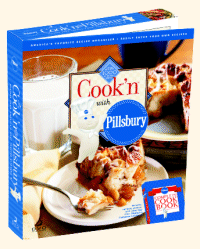
|
Never miss another recipe... Sign up for our free monthly newsletter today!
Subscribing will not result in more spam! I guarantee it! NEWSLETTER
• Current Issue• Newsletter Archive • Sign Up Now 
Cook'n with Betty Crocker 
Cook'n with Pillsbury 
Cook'n with a Taste of Home 
Cook'n in Italy 
Cook'n in Mexico |
 |
Go Slow For Success |
|
Print this Recipe When changing habits, whether it’s eating, activity or other health-promoting plans, realizing the value of making gradual changes is important. You’ve spent a lifetime developing your current habits; if you expect to change all of them overnight, you may be disappointed. Success is greatest for those who set realistic goals, thoughtfully plan their strategies for reaching their goals, and then break their goals into small, doable steps. Take on one or two challenges, and give yourself time to adjust to the changes. Small changes can turn into new lifetime habits that herald good health. Plan strategies that will help you overcome your hurdles. For example, if you eat too many high-fat foods and too few fruits, vegetables and complex carbohydrates, resolve to eat apple wedges, red bell pepper rings or pretzels instead of chips with your noontime sandwich. Change your standard breakfast to fat-free (skim) milk, cereal and fruit instead of doughnuts or pastries. Cut back on the amount of meat you eat by preparing meals that are combinations of vegetables, meat and complex carbohydrates such as mixed rice or pasta dishes. Remember, there’s no need to completely forgo your favorite foods. You can continue to eat these foods occasionally. Once you have control over the problem areas at the top of your list, move on to other areas that you think needs improvement. If even after reducing the amount of fat in your diet, you find that you’re still eating a bit too much and consequently weigh more than you’d like to, work to reduce your portion sizes. Or if regular exercise is a problem for you, focus on increasing your activity level, thereby burning up those extra calories. Deciding to make changes, whether in your diet, your level of physical activity or your outlook on life, is the easy part. Sticking with the changes is the challenge. You can do it; here’s how: * Decide what is important to you in terms of your health. * Determine what you can do, what steps you can take to stay well. * Break those steps into reasonable chunks. For example, if you choose to get your cholesterol level into the healthy range and part of your plan to get there is to eat less high-fat snack foods, then come up with realistic strategies for avoiding chips and high-fat crackers. You may choose to always have a piece of fruit handy at 2 p.m. in the afternoon. * Check your progress regularly, then make adjustments as needed. * Stay true to your goal even when your behavior is less than perfect. It happens, and it’s okay. Recognize your successes, and reward yourself for your stick-to-itiveness. Best wishes for good health! Nutrition Criteria For Flags Every recipe in this book meets at least one of the fat or cholesterol nutrition criteria described below, and most meet both fat and cholesterol criteria. Most recipes meet the loc-calorie criteria, as well. The nutrition information that accompanies each recipe, along with the special nutrition criteria flags and Diet Exchanges, will help you make healthy food choices. It is unrealistic to expect each dish or even each meal to meet all nutrition guidelines. What’s important is to look at total fat, cholesterol and calorie intake over an entire day. This chapter and the recipes that follow give you the information you need and the food you love to put together a healthy eating plan for yourself and your family. Low Fat Main-dish recipes have 10 or fewer grams of fat per serving. Low-fat side dishes and desserts have 3 or fewer grams of fat per serving. Low Cholesterol Recipes have 90 or fewer milligrams of cholesterol per serving. Low Calorie Recipes have 350 or fewer calories per serving with the exception of desserts. Low-calorie desserts have 250 or fewer calories per serving. From "Betty Crocker's Low-Fat, Low-Cholesterol Cooking Today." Text Copyright 2005 General Mills, Inc. Used with permission of the publisher, Wiley Publishing, Inc. All Rights Reserved. This recipe comes from the Cook'n collection. Try Cook'n for FREE! Here’s to your health Fat Facts Understanding Cholesterol Other Important Nutrients Putting It All Together Reading a Nutrition Label Go Slow For Success Test Your Health IQ The Skinny on Fat Cholesterol Trimming Tips Nutritional Comparison |
|
|
Affiliate Program | Privacy Policy | Other Resources | Contact Us
© 2008 DVO Enterprises, Inc. All rights reserved. Sales: 1-888-462-6656 |

